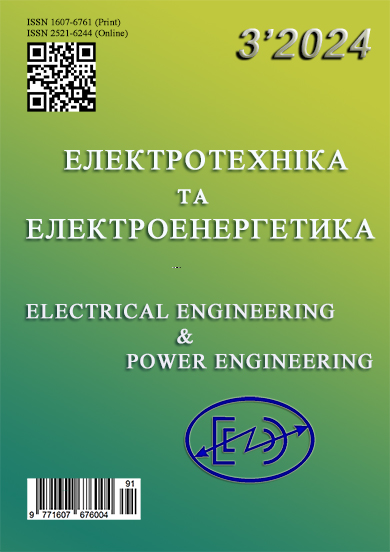Determination of converter parameters for high-voltage electromechanical systems of stationary installations of industrial fans
DOI:
https://doi.org/10.15588/1607-6761-2024-3-1Keywords:
converter, parameters of the rotor circuit, electromechanical system, energy efficiency, high voltageAbstract
Purpose. To study the electromagnetic processes in the circuit of the phase rotor of a high-voltage induction motor connected to the network through a step-up converter, to determine the parameters of the converter and their relationship with the voltage gain to ensure the optimal level of energy efficiency of the electromechanical system.
Methodology. Methods of theoretical electrical engineering for the construction of a rotor circuit replacement scheme for an induction motor with a step-up converter, methods for solving a system of first-order differential equations, analytical methods.
Findings. The expediency of using a converter that combines the rotor circuit of a high-voltage induction motor with the power supply network and provides regulation of the rotor EMF with the recovery of the slip energy of the induction motor rotor to the power supply network has been proved. This will ensure speed control of powerful high-voltage induction motors on the rotor side with an EMF of up to 600 V and significantly reduce the cost of a high-voltage electromechanical system. A methodology for determining the converter gain and the parameters of the rotor circuit of the electromechanical system is proposed, which allows determining the transformation ratio of the matching transformer at the optimal value of the voltage gain. The conditions of trouble-free operation of the inverter at the moment of start-up of the electromechanical system are determined. Achieving these conditions is ensured by determining the delay of the control signal to the power keys of the inverter of a step-up converter. The correlation between the voltage gain and the equivalent resistance of the rotor circuit of the electromechanical system is established.
Originality. The ratio of the voltage gain to the equivalent resistance of the rotor circuit of the electromechanical system is established, which will ensure the matching of the rotor EMF with the voltage of the power supply network while maintaining a high level of energy efficiency.
Practical value. A methodology for determining the gain and parameters of a step-up converter is proposed, which allows determining the transformation ratio of a matching transformer at the optimal value of the voltage gain. The proposed methodology can be applied to the modelling of complex powerful high-voltage electromechanical systems, especially for stationary installations of industrial fans.
References
Kotsur M., Yarymbash D., Kotsur I., Yu. Bezverkh-nia. (2018). Speed Synchronization Methods of the Ener-gy-Efficient Electric Drive System for Induction Mo-tors. IEEE: 14th International Conference on Ad-vanced Trends in Radioelectronics, Telecommunica-tions and Computer Engineering (TCSET), February 20-24, Lviv-Slavske, Ukraine, 304-307 DOI:10.1109/TCSET.2018.8336208.
Pivnyak, G.G. and Volkov A.V. (2006) Sovremennye chastotno-reguliruemye asinkhronnye elektroprivody s shirotno-impul’snoi modulyaciey [Modern Fre-quency Controlled Asynchronous Electric Drives with Pulse-Width Modulation], Dnipropetrovsk: Natsion-alnyyi girnychiyi Universytet, Ukraine – 470 p.
Lozinskyi A. O., Moroz V. I., Paranchuk Ya. S. (2007). Solving problems of electromechanics in the envi-ronments of MathCAD and MATLAB packages. Magnolia, 215.
Dubey, G.K. (2008). Power semiconductor controlled drives. PHI. Edition, 440.
Antoshchenko N. I., Kalyuzhny V. V., Kotikov V. P., Tynda G. B., Andrienko P. D., Sadovoy A. V. (2014). New approach to regulation of ventilation of coal. Coal of Ukraine, 3, 29-32.
Onishchenko G.B. (2006) Elektricheskiy privod [Elec-tric Drive], Мoscow, Publishing House "Academia", 288 p.
Volkov I. V., Stiazhkin S.V.,Podolnyi S. V. (2009). Sys-temy stabilizirovannogo toka dlya avtomatiziro-vannykh elektroprivodov [System of stabilized cur-rent for automated electric drives], Trudih Instituta Elektrodinamiki NAN Ukrainih, 23, 64-72.
Andrienko P.D., Kotsur M. I., Kotsur I.M. (2011) Pa-tent of Ukraine 64126, Int. Cl.3 Н02Р 27/05(2006.01) Prystryi impulsnogo keruvannya procesamy peretvorennya energiyi v asinkhronnomu dvyguni z faznym rotorom. [Device for impulse con-trol by energy coversion processes in wound-rotor in-duction motor] published 25.10.2011, Bulletin №20,
Kotsur M. I., Andrienko P. D., Kotsur I. M. (2012). Osobennosti rezhimov raboty modificirovannoy sis-temy impulsnogo regulirovaniya [Operation modes features of modificate pulse control system of asyn-chronous motor with phase rotor], Elektrome-chanichni ta enegrozberigayuchi sistemy, 19, 3, 163-165.
M. I. Kotsur, A. A. Andrienko, D. S. Andrienko, O. V. Nemykina (2016). Regulated asynchronous electric drive with improved characteristics, Electrical engi-neering and computer systems,22(98), 74 – 78.
Kotsur M.I., Kotsur I.M., Bliznyakov A.V. (2015). Increase effectiveness of reversible braking mode re-alization of the wound-rotor induction motor, East-ern-European Journal of Enterprise Technologies, Volume 1, Issue 8, pp. 27-30. DOI: http://dx.doi.org/10.15587/1729-4061.2015.36670.
Shaviolkin O.V. (2015). Power semiconductor energy converters, KhNUM University named after OHM. Beketova, 403.
Pereverzev, A.V. (2004). Characteristics of step-up converters for uninterruptible power supply systems, Tekhnichna Elektrodinamika, 239.
Downloads
Published
How to Cite
Issue
Section
License
Copyright (c) 2024 A.V. Synetskyi, I.M. Kotsur

This work is licensed under a Creative Commons Attribution-ShareAlike 4.0 International License.
Creative Commons Licensing Notifications in the Copyright Notices
Authors who publish with this journal agree to the following terms:
Authors retain copyright and grant the journal right of first publication with the work simultaneously licensed under aCreative Commons Attribution License that allows others to share the work with an acknowledgement of the work's authorship and initial publication in this journal.
Authors are able to enter into separate, additional contractual arrangements for the non-exclusive distribution of the journal's published version of the work (e.g., post it to an institutional repository or publish it in a book), with an acknowledgement of its initial publication in this journal.
Authors are permitted and encouraged to post their work online (e.g., in institutional repositories or on their website) prior to and during the submission process, as it can lead to productive exchanges, as well as earlier and greater citation of published work.

